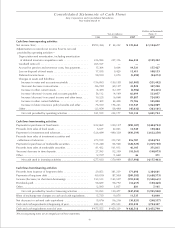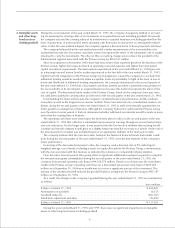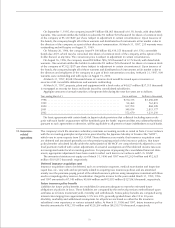Sony 1997 Annual Report Download - page 47
Download and view the complete annual report
Please find page 47 of the 1997 Sony annual report below. You can navigate through the pages in the report by either clicking on the pages listed below, or by using the keyword search tool below to find specific information within the annual report.
45
contracts. This association is accomplished through a provision for liabilities for future benefits and
amortization of acquisition costs.
Cash and cash equivalents
Cash and cash equivalents include all highly liquid investments, generally with original maturities of three
months or less, that are readily convertible to known amounts of cash and are so near maturity that they
present insignificant risk of changes in value because of changes in interest rates.
Debt and equity securities
On April 1, 1994, the company adopted Statement of Financial Accounting Standards No. 115 (FAS 115),
Accounting for Certain Investments in Debt and Equity Securities, and recorded ¥73,000 million of unrealized
gains on available-for-sale securities as a separate component of stockholders’ equity on a net of tax basis.
Under FAS 115, unrealized gains and losses on debt securities and equity securities classified as available-for-
sale, whose fair values are readily determinable, are reported in a separate component of stockholders’ equity,
net of tax. Debt securities that are expected to be held to maturity are reported at amortized cost.
Inventories
Inventories in electronics and music entertainment are valued at cost, not in excess of market, cost being
determined on the “average cost” basis except for the cost of finished products carried by certain subsidiary
companies which is determined on the “first-in, first-out” basis.
Film costs include production, print, certain advertising costs and allocated overhead. Film costs are
amortized in the proportion that revenue for a period relates to management’s estimate of ultimate revenues.
Unamortized film costs are compared with estimated net realizable value on an individual film basis and
write-downs are recorded when indicated. Film costs for motion pictures and television programs that are
expected to be amortized against revenues from primary markets are classified as current assets. Primary
markets for motion pictures include theatrical, home videocassette and pay television. Primary markets for
television programs include network and first-run syndication. All other film costs are classified as noncurrent.
Property, plant and equipment and depreciation
Property, plant and equipment is stated at cost. Depreciation of property, plant and equipment is computed
on the declining-balance method for the parent company and Japanese subsidiaries and on the straight-line
method for foreign subsidiary companies at rates based on estimated useful lives of the assets according to
general class, type of construction and use. Significant renewals and additions are capitalized at cost.
Maintenance and repairs and minor renewals and betterments are charged to income as incurred.
Intangibles and goodwill
Intangibles, which mainly consist of artist contracts and music catalogs, are being amortized on a straight-line
basis principally over 16 years and 21 years, respectively.
Goodwill recognized in acquisitions accounted for as purchases is being amortized on a straight-line basis
principally over a 40-year period.
Deferred insurance acquisition costs
Costs that vary with and are primarily related to acquiring new insurance policies are deferred and are being
amortized mainly over the premium-paying period of the related insurance policies using assumptions
consistent with those used in computing policy reserves.
Liability for insurance future policy benefits
Liability for insurance future policy benefits is computed based on actuarial assumptions.
Accounting for the impairment of long-lived assets
During the fiscal year ended March 31, 1997, the company has adopted FAS 121, Accounting for the Impair-
ment of Long-Lived Assets and for Long-Lived Assets to Be Disposed Of, which requires that long-lived assets
and certain identifiable intangibles held and used be reviewed for impairment whenever events or changes in
circumstances indicate that the carrying amount of the assets or intangibles may not be recoverable. The
effect of adopting this statement was not material.
Income taxes
The provision for income taxes is computed based on the pretax income (loss) included in the consolidated
statements of income. The asset and liability approach is used to recognize deferred tax assets and liabilities
for the expected future tax consequences of temporary differences between the carrying amounts and the tax
bases of assets and liabilities.
























